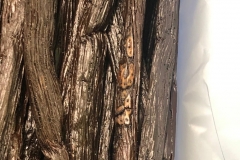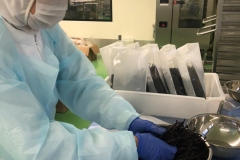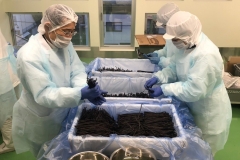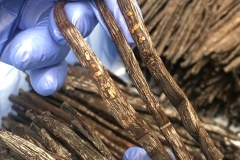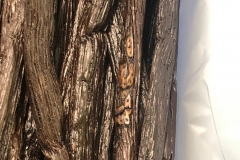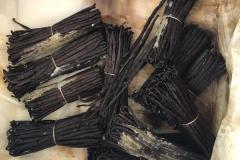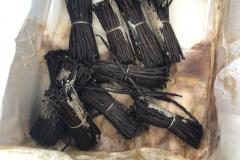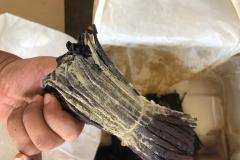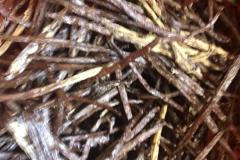Vanilla Mold & Vanillin Crystals
Mold, a white microbial or fungal-looking substance, grows and spreads on vanilla beans that have too much moisture, too little vanillin content, and that haven’t been cured or matured and prepared properly.
Moldy vanilla beans are the result of illegal or improper vanilla practices, and scam sellers, and/or vanilla being sold at too high a humidity point.
There is an exact ratio of humidity content to vanillin percent that can guarantee scientifically that beans will not have mold.
Vanillin is the natural end expression of the benzenoid crystal that matures inside the pod and can create phenol and medicinal alcohol smell if diverted by “premature” cutting, or a delicious dark fragrant vanilla smell, depending on when the bean is cut, and how it is prepared for sale.
Mold-proneness and susceptibility usually cannot be stopped, and even if cleaned from a bean, due to its natural defenses and molecular composition, even if dried as well, can come back. If vacuum packed and suffocated further, beans will mold and bloom and destroy whole batches. Moldy beans should be thrown out, and in addition, vacuum packing is sometimes used to hide mold which blooms weeks or a month later.
In general, vanilla companies can knowingly sell mold beans in good temporarily stable condition, that then mold after a few days or weeks, even up to a month, after opening. This way they can plausibly blame the mold on the customer, and offload defective spoiled stock without having to refund.
Mold beans are illegal to export of course, but also are recently a common problem with inexperienced or dishonest exporters, and even plenty of sellers in America, Asia, and Europe. Some of the largst companies have been victims or perpetrators.
If you find mold on vanilla beans, destroy it and/or demand it replaced, and do not believe the claims of your furnisher that they can be cleaned with an alcohol treatment and then live a normal life and flavor expression, though if extracted they should not present a problem with the extract. The beans do not have enough matured flavor profile and not enough vanillin inside, plus too much moisture and mold within the husk, skin, and plant matter of the bean.
Vanillin crystals also sometimes have the brownish-white appearance of mold but are a natural concentrate of the active ingredient. These are to be enjoyed and are very healthy and signal excellent quality of the vanilla beans.
You can tell the difference between vanillin crystals and residue vs mold on vanilla beans, by the color and character of the spots.
Mold is a fluffy and cottony substance and starcher white, not droplets, and looks like fuzz or dry bleachy foam matter.
Vanillin within properly cured vanilla pods functions as an important immune system, and when beans are scalded (boiled) to kill its plant-life, the vanillin should be high enough (mature) first at this point to stimulate natural immune resistance to mold. Oceanic shipping malpractice, or stowing in cargo holds of ships bound under cover of night to Tamatave from Sambava or Antalaha (which has a port) has resulted in moldy vanilla scandals after taking on moisture in the stocks in transit from many inexperienced vanilla buyers or producers in the past years. Packing and transit in a proper environment for vanilla is important and vital enough to make airlifting them a majority more sensible and safe solution, since 2015-19.
While a good and honest-dealing vanilla company (or else from another perspective, just one with the experience to know how to cure beans effectively and how fungal and orchid organisms interact and molecular biology works,) will reimburse and accept returns of their molded beans, as MVC would and many of the other good companies in Madagascar. However, for years the vanilla export market across Madagascar also has many instances of malicious customers swapping foreign (external origin) beans in photo sets and returned “stocks” to offload out on their non-originators, in order to attempt fraudulent returns and profit-margin-capture. As a preventative counter arms-race measure, most returned beans in 2018 and 2019 across Madagascar and even Tahiti, Papua New Guinea, and other places are now lot-match checked, farm-pegged, or tracked (or just tattoed traditionally) to ensure the “returned” beans are actually the same exported, and not somebody else’s. Tracking technology and ISO standards have so made business easier for Madagascar vanilla professionals in this way, and in tandem with the basic non-electronic security tech of simple tattooing, has helped with attribution and eliminating the mold problem as well as bad exporters and bad customers.
Crystals look like white/brownish yellow rain droplets or literally shiny sharp glass-like tiny “diamonds” of vanilla, such as the THC residue on excellent marijuana plants.
When vanilla beans have unusually large crystalline vanillin evident, they can be pulled out for decoration and kept for years, even 10 year+, under excellent condition in glass tubes or jars, as the crystals make for elegant displays and mean the stability of the bean is high and will not mold.
Crystalline beans have an amazing smell to them, however, dry out over time and so the smell and flavor packs into the plant matter but does not diffuse aromatically through the air without interaction or extraction as much over time. The flavor soaks deep into the skin and seeds and retains inside the bean and its crystals.
MVC vanilla guarantees no mold and long-lasting excellent stable flavor
MVC food handling facilties in Japan taking sanitary precautions in triple-checking and packaging vanilla bean by bean
Mold that grows on vanilla pods, in several different species, creates mycelial networks that can actually communicate from one bean to another bean in the same box through thin air, almost like a radio receiver. (Actually it is still not known how many species exist that can penetrate uncured/miscured vanilla that has not dried and finished enough to activate the vanillin’s anti-fungal property.) Since the fungus can actually learn which way to move and expand like feet or roots, beans generally will remold in the same places even if they have been washed (after they are already compromised) and unless they are further dried and sunned to crystallize enough vanillin. If any mold exists and has no anti fungal biological mechanism in the bean still to stock it, it will remember the paths the mycelium took, and repeat the mold bloom – on the same spots on the same beans. If vanilla beans are too wet it is either intentionally or accidentally, but in both cases the ratio of vanillin to moisture is not over the magical lever where the crystal wards off the mycelium and mold in the plant matter. In the deliberate (malicious) circumstance the beans are provided like this to inflate margins and cheat the customer, and in the latter accidental case, it is the result of amateurs who do not really know how to cure the vanilla properly and are either too inexperienced or too greedy, or the result of poor shipping and opening of the boxes or packages and exposing them to terrible humidity and heat conditions. Every year there is vanilla that arrives and is seized by customs worldwide as moldy, or even seized with mold in Tana or Tamatave and returned months later to the sender, and many of these mold megabombs are a clients relentlessly bargaining and driving down prices online and bargaining all the way to the bottom naively with small vendors who give prices too good to be true.
Overall the whole island’s yield quality has dropped since about 2012 (the same time prices sharply increased) and profits were focused on by dilletantes and dubious traders and sellers over a finished product. Quick curing and leaving as much moisture as possible in as little time as possible has led to many issues over the years. Ideally if an American or any customer wanted poorly-cured vanilla that reeked of chemicals, they’d import vanilla beans from Indonesia and PNG at a fraction of the cost, which Malagasy do not seem aware of.
When people have to change gloves because they can’t even hold on to the vanilla beans because of the moisture, there is a major problem. When staining of the packaging happens after handling beans after each package, there is a major problem. When you walk into sorting and packaging and the first thing on your mind is “what’s that odd odor” instead of “smell that heavenly vanilla”, you have a problem. Vanilla when bound in nylon rather than toasted raffia (to eradicate growth and moisture/fungi) exhibits signs of mold often when it hits the foreign destination. When vanilla is not bound or bundled phytosanitarily, you have a problem. All of these things bely a crisis of curing and cost-squeezing that really forfeit the reputation of the Madagascar firm and friendship with consumers that sprung the export.
Well cured vanilla – reminiscent of cake has a pruny texture but still soft and smooth with a waxy sheen and occasionally tacky to the touch. Consistent brown-black color with little or no red streaking. HIgh variability in the “beanotype-phenotype” – the range, branding, and spurious curing practices, generally as a rule of thumb means that a vanilla provider does not have any control over existing stock and are an additional middleman in the chain. A lot of American firms use multi-billion-dollar-sized vanilla MNCs for monthly wholesale and other smaller or more ear-to-ground Malagasy suppliers to make up the difference. While a powerhouse and punctual solution for worldwide vanilla, large firms like the top industrial exporters charge a lot more per kilo, but in exchange customers don’t have to have a presence on the island and put up with nonsense and fake news from vanilla professionals trying to spin tails of paperwork and price hikes all day.





